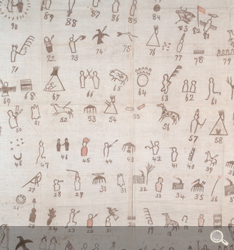

Before and After the Ledger Drawings
Long before ledger drawings, Plains men documented personal and tribal history through symbolic drawings on rock or hide warshirts, tipi covers, and robes. Each Lakota Sioux band, for example, had a community historian who kept track of the year’s events through drawings on hide or muslin. These visual histories, known as winter counts, were added to, year by year, often recopied by successors, and used in combination with oral narrative to present the historical record. The Kiowa marked history on calendars, with events recorded in summer and winter.
Older systems of keeping history and the ledger histories both had a major influence on contemporary Indian art. The styles and subject matter of the pictographic histories and ledger drawings came to life in the artwork produced in the Indian boarding schools. More recently, Native men and women are taking the ledger drawings as inspirations for new art. Often using ledger and notebook paper, these artists transform the older traditions into humorous, highly political commentary on the life gone by and on their revitalized Native world.
The Flame Winter Count (Sioux) records the years 1786-1876 Courtesy National Anthropological Archives, Smithsonian Institution
"Honored," Francis Yellow (Francis J. Yellow), Lakota (Teton/Western Sioux) Courtesy, National Museum of the American Indian

